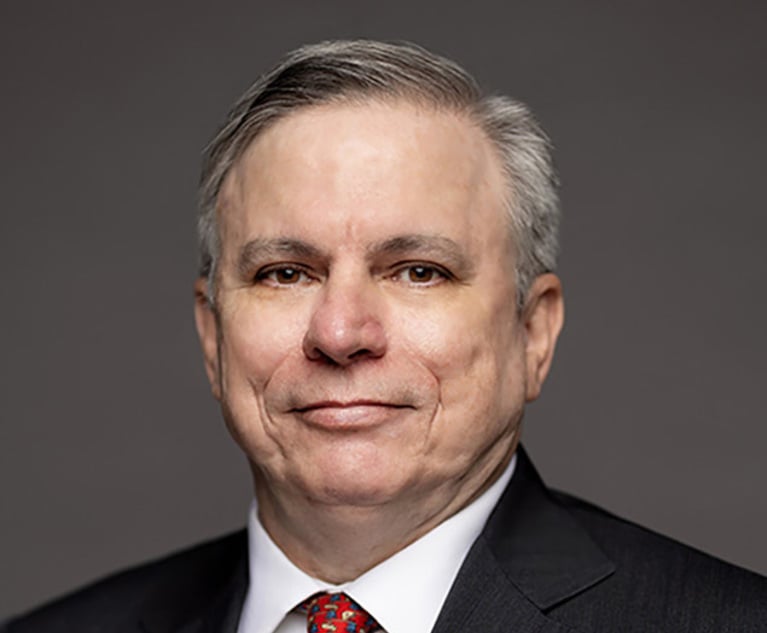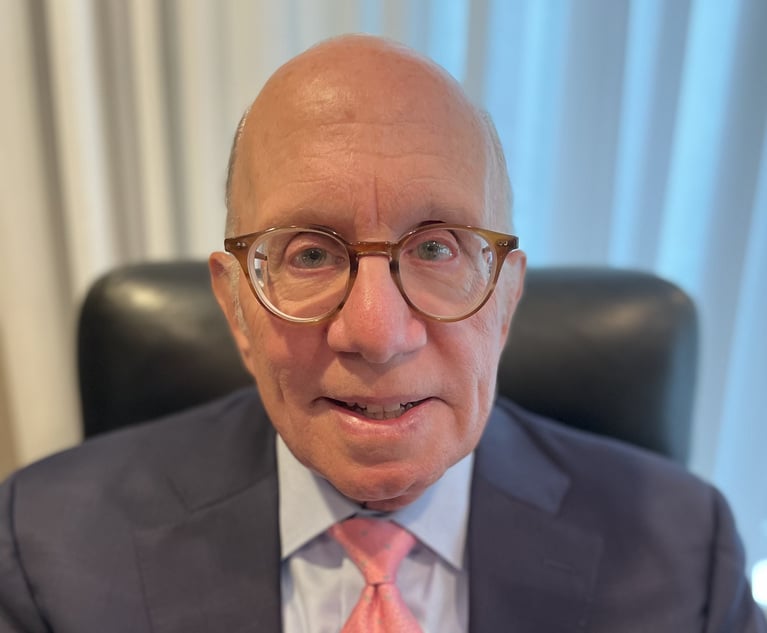 A view of the Yarra River, Melbourne, Victoria, Australia.
A view of the Yarra River, Melbourne, Victoria, Australia.Whimsical Reflections From Expert Witness 'Rocking Chairs': Part 3
This essay is a "step back" from the author's tenure in different roles at the Court of Appeals spanning the last quarter of the last century. The reminiscences recounted here, however, are from his more recent endeavors as a witness in various cases.
February 13, 2020 at 11:45 AM
10 minute read
This is part three of a four-part article describing experiences from "the other side of the bench."
Life in turbulent times is more tolerable when softened through whimsical twinkling eyes taking a look back. In that spirit, this exertion is a "step back" from my tenure in different roles at the Court of Appeals spanning the last quarter of the last century (1975 to 2000). The reminiscences, however, are principally of more recent vintage (2005-2017) that emanate after my judicial and academic careers. During the "retirement" stage from affiliated postings, I accepted a few engagements that landed me in witness chairs. Part 1 and Part 2 recounted my experiences at the Tortola High Court of Justice, British Virgin Islands Commercial Division in the Eastern Caribbean, and at the High Court of Justice, Queen's Bench Commercial Division, in London, respectively. We now go "Down Under" with Part 3.
Melbourne Australia: Three-Member International Arbitration Tribunal. To set the stage for this "retirement" expert-witness testimonial experience, I note that the contract interpretation dispute in this instance was in an arbitration proceeding that was governed by a standard New York law clause. The dispute involved multi-millions of royalty payments that, eventually over many decades, grew into a billion-dollar brouhaha. The claimant, a geologist from Connecticut, had charted a vast hydrocarbon field off the coast of Australia. He and his successors in interest sought to keep the royalty payments flowing after decades of payments—just as long as the hydrocarbons kept being pumped. The substantive clause—a royalty payment—provided a modest percentage figure of the monetary value (huge) of the recovered hydrocarbons. It had no termination date or fixed period of time. That precipitated the dispute as to how long, if indeed in perpetuity, the royalty payments were to continue, implicating even the venerable "Rule Against Perpetuities"—a decidedly non-whimsical collateral issue of considerable complexity and dimension.
It so happened that this was to be the second arbitral trial of the dispute because the first award was overturned by the Supreme Court of Australia. All new experts, including me, were engaged for a de novo replay. The decades-old agreement and the dispute had dragged on so long, with an unsettling collateral Perpetuities wrinkle that it had the feel of Charles Dickens' famous multi-generational case of Jarndyce v. Jarndyce in "Bleak House."
My New York law expert report for the claimant was one of several submitted on both sides of the long-running dispute. The hydrocarbon mining corporation, after decades of payments to the charting geologist and his successors in interest, had determined to cap that well-head. The hearing was held in a modern courthouse in Melbourne before an international arbitration panel consisting of three eminently experienced professionals.
My cross examination—after my report was simply moved to be placed in evidence (no direct examination)—was to be conducted by an experienced Australian Queen's Counsel. His goal was to eviscerate the substance and impact of my law expert report on New York law, presented with the other reports to instruct and assist the panel as it found helpful. The panel was comprised of a retired Chief Justice of Australia, a Queen's Counsel brought in from London to preside, and a pre-eminent New York City private bar arbitrator with an extensive international reputation. Together, this skilled tribunal had wide-ranging experience.
The flight (door-to-door a grueling 35+ hours) started from my home in Ridgefield, Conn. in a bitter-cold 10-degree heavy winter snowstorm, with flight delays at both U.S. ends; at LAX, my wife and I boarded the "Down Under" Qantas long leg (15 hours) flight, direct to Melbourne. We landed in summer heat of 95 degrees—still wearing our heavy layered New England storm winter clothes. Exhausted with serious jet lag, I was promptly whisked off, nevertheless, to a full day of witness preparation with the local barrister, who represented the claimant at trial, on whose behalf I had been engaged through a major New York law firm and the local Australian solicitors.
Part of my trial preparation was a forewarning that the expected cross-examining barrister had a no-nonsense reputation. I was advised that he would give no credit based on former rank or credentials of witnesses whose evidence he intended to discredit. So, before I took the stand and was sworn at an afternoon session on the second day of the hearing, I was instructed to say as little as possible in the fewest words. This was an unfamiliar mode for a chatterbox like me, and the dynamic was unsettling because of the stark preparation warnings. I reminded myself that it, too, would not enjoy a benign "May it Please Your Former High Honorable Sir!!"
Sure enough, with ramrod stance at the counsel table, standing slightly angled and askew towards me and the bench with one arm akimbo (a power stance), the barrister's body language projected disdainful sufferance. If he wanted to look intimidating, he succeeded. He surely wanted me to feel his sullen rejection of the content and quality of my evidentiary report. Without delay and with evident dubiety, he bore right into me and the report, line by line. Testily, he sought to shred the report with suppositions and predicates built into his questions, irrespective of my answers. He probed hard to shake my confidence about the principles of New York law that I had assembled in my report.
After laying a foundation for a seeming trap with that tactic, he switched gears and started to edge into forbidden territory. I had been warned not to take that bait, but also not get into a dispute with him on an equal plane, and especially not as if I were still a judge. He framed his insinuations in a way as to get me to apply the legal principles on which I had simply opined, so that conclusions might appear absurd or wrong or just founder. Even as I hedged, I worried that my demeanor might be interpreted as evasive or worse disputatious. It was a tightrope walk, and as uncertain as I was as to how the panel was assessing our fencing, I had no uncertainty about how the barrister was taking it—not well, and with open irritation and loss of patience.
As he persisted in pushing me beyond the opinion limitation, the pre-hearing warnings kept ringing in my inner ear—stand firm, but do not go toe-to-toe. Yet, a palpable tension was building between us because he was leading with loaded questions beyond my defined portfolio, which was simply to propound the principles of law, and not apply them. Who might blink first, flashed before my mind's eye several times?
In his barrister robe, with an arm-wave of bravado, he sarcastically declared that I was being evasive and had an obligation to answer his questions. As I squirmed in the witness seat at this sharp rebuff, the panel chairman suddenly sat up ramrod straight and intervened. Like a floundering swimmer seeing a life preserver flung in his direction, I hung onto the firm admonition I heard directed to the Barrister. The chairman declared that counsel was trying to elicit answers from the witness to which he was not entitled. In no uncertain terms, he ruled that seeking answers to the questions of application and conclusions were off limits with the witness; that, he stated, was the exclusive province of the panel. After some sparring between them, to which I was a stone-faced observer (grinning interiorly), the barrister requested a recess to consult privately and consider his options from the limiting instructions.
Turning next to me, the chairman instructed that I remain seated in the witness chair, unless I needed a break. I chose to stay put, and after 15-minutes or so—it seemed agonizingly longer—a clerk brought a note up to the panel that evidently requested more recess time. The time was extended and as it dragged on, I squirmed, drank water, and stared into the still space of the courtroom. At a point approaching a customary late afternoon recess, the barrister finally returned to the courtroom (the 15 minutes had extended to almost 45), and stepped back to his place at the counsel table. He was asked by the chairman whether he wished to proceed and if so how much time might he need to finish with this witness. When the answer came out as equivocal, the hearing was abruptly recessed until the following morning.
The chairman then turned his attention back to me with solicitous apologies for the inconvenience of the delay and the necessity of a return for a second day of testimony. He instructed me that as a sworn continuing witness, my oath remained binding, and that I should not converse overnight with anyone, especially not counsel. I was asked whether I had any questions about that restriction. Up to then, I had been a tight-lipped witness, but in the moment, having taken the temperature of what had just occurred, I sensed an opportunity for a small human touch. I replied directly that I understood the instruction, as it was substantially the same under New York practice.
Then with a gulp, I added that my only companion for the evening was my wife for dinner and under no circumstances would she want to hear anything that happened in court as she hadn't the slightest interest in the case. Everyone smiled, some even laughed at the ease of the exchange. I noticed the three panel members—to whom I had directed that comment—smiling, too. Scowling across the room, however, was my nemesis barrister, not at all amused by the afternoon's developments and quite irked by my successful charm offensive with the panel.
The next morning, I was first up to the stand, seated well before everyone else was in attendance and ready to go again. To my utter surprise (and ultimate delight) the barrister stood up, evidently chastened, and asked me a few perfunctory questions, before announcing to the panel that he had nothing further for or from this witness. I was excused and done. I and my wife were released to a delightful, relaxing and fascinating first-time tourist vacation in Melbourne and Sydney for the whole next week in beautiful Australia.
My participation played some part in an eventual billion-plus-dollar award—so I was later informed. For me, though, the most telling memory was the whimsical rescue from the clutches of an over-bearing barrister.
Joseph W. Bellacosa is a retired judge of the New York Court of Appeals.
Other articles in this series:
This content has been archived. It is available through our partners, LexisNexis® and Bloomberg Law.
To view this content, please continue to their sites.
Not a Lexis Subscriber?
Subscribe Now
Not a Bloomberg Law Subscriber?
Subscribe Now
NOT FOR REPRINT
© 2024 ALM Global, LLC, All Rights Reserved. Request academic re-use from www.copyright.com. All other uses, submit a request to [email protected]. For more information visit Asset & Logo Licensing.
You Might Like
View All
Patent Trolls Come Under Increasing Fire in Federal Courts

Why Is It Becoming More Difficult for Businesses to Mandate Arbitration of Employment Disputes?
6 minute readTrending Stories
- 1Mediators for the Southern District of New York Honored at Eighth Annual James Duane Awards
- 2The Lawyers Picked by Trump for Key Roles in His Second Term
- 3Pa. High Court to Weigh Parent Company's Liability for Dissolved Subsidiary's Conduct
- 4Depo-Provera MDL Could Be Headed to California
- 5Judge Holds New York City in Contempt Over Conditions at City Jails
Who Got The Work
Michael G. Bongiorno, Andrew Scott Dulberg and Elizabeth E. Driscoll from Wilmer Cutler Pickering Hale and Dorr have stepped in to represent Symbotic Inc., an A.I.-enabled technology platform that focuses on increasing supply chain efficiency, and other defendants in a pending shareholder derivative lawsuit. The case, filed Oct. 2 in Massachusetts District Court by the Brown Law Firm on behalf of Stephen Austen, accuses certain officers and directors of misleading investors in regard to Symbotic's potential for margin growth by failing to disclose that the company was not equipped to timely deploy its systems or manage expenses through project delays. The case, assigned to U.S. District Judge Nathaniel M. Gorton, is 1:24-cv-12522, Austen v. Cohen et al.
Who Got The Work
Edmund Polubinski and Marie Killmond of Davis Polk & Wardwell have entered appearances for data platform software development company MongoDB and other defendants in a pending shareholder derivative lawsuit. The action, filed Oct. 7 in New York Southern District Court by the Brown Law Firm, accuses the company's directors and/or officers of falsely expressing confidence in the company’s restructuring of its sales incentive plan and downplaying the severity of decreases in its upfront commitments. The case is 1:24-cv-07594, Roy v. Ittycheria et al.
Who Got The Work
Amy O. Bruchs and Kurt F. Ellison of Michael Best & Friedrich have entered appearances for Epic Systems Corp. in a pending employment discrimination lawsuit. The suit was filed Sept. 7 in Wisconsin Western District Court by Levine Eisberner LLC and Siri & Glimstad on behalf of a project manager who claims that he was wrongfully terminated after applying for a religious exemption to the defendant's COVID-19 vaccine mandate. The case, assigned to U.S. Magistrate Judge Anita Marie Boor, is 3:24-cv-00630, Secker, Nathan v. Epic Systems Corporation.
Who Got The Work
David X. Sullivan, Thomas J. Finn and Gregory A. Hall from McCarter & English have entered appearances for Sunrun Installation Services in a pending civil rights lawsuit. The complaint was filed Sept. 4 in Connecticut District Court by attorney Robert M. Berke on behalf of former employee George Edward Steins, who was arrested and charged with employing an unregistered home improvement salesperson. The complaint alleges that had Sunrun informed the Connecticut Department of Consumer Protection that the plaintiff's employment had ended in 2017 and that he no longer held Sunrun's home improvement contractor license, he would not have been hit with charges, which were dismissed in May 2024. The case, assigned to U.S. District Judge Jeffrey A. Meyer, is 3:24-cv-01423, Steins v. Sunrun, Inc. et al.
Who Got The Work
Greenberg Traurig shareholder Joshua L. Raskin has entered an appearance for boohoo.com UK Ltd. in a pending patent infringement lawsuit. The suit, filed Sept. 3 in Texas Eastern District Court by Rozier Hardt McDonough on behalf of Alto Dynamics, asserts five patents related to an online shopping platform. The case, assigned to U.S. District Judge Rodney Gilstrap, is 2:24-cv-00719, Alto Dynamics, LLC v. boohoo.com UK Limited.
Featured Firms
Law Offices of Gary Martin Hays & Associates, P.C.
(470) 294-1674
Law Offices of Mark E. Salomone
(857) 444-6468
Smith & Hassler
(713) 739-1250








